Disclaimer: FishTechOutdoors is community supported. We may earn a commission when you make a purchase through one of our links. As an Amazon associate, we earn from qualifying purchases. Learn more.
Fisherman's Guide to the Best Bass Lures
Bass fishing isn't as easy as throwing a line in the water and "getting lucky". Using the right bass lures is what makes all the difference in the world.
Last updated: October 1, 2024
By: Jon Stewart
Ah, the world of bass fishing.
We all know there are massive bass out there, just waiting to be caught.
But how do we catch them?
Answer: It all comes down to the lure.
The type of action presented by the lure, the color, the depth where you’re using it, the water temperature and time of day, the local food sources all play a major role. There’s really no one size fits all answer here (the closest thing would be Truscend’s new spinner jig).
To make sure you’re prepared for every possible situation, we’ve compiled a list of the best bass fishing lures which will prepare you for any situation out there—lakes, ponds, varying water and temperature conditions, and more.
If you’re not catching big bass, the first thing you need to do is change your lure. But if you don’t have the basic lures in your tackle box, then you’re already a step behind.
Here are the fundamental bass fishing lures that every bass angler needs.
Let's dive in!
Most Popular Bass Fishing Lures 🏆
1. Best Overall: Spinnerbaits
2. Best for Deep Water: Crankbaits
3. Best from the Shore: Top Water Poppers
4. Best for Cover: Jigs
5. Best in a Pond: Rubber Worms
6. Best in the Fall: Jerkbaits
7. Best When Nothing Else Works: Swimbaits
8. Bonus: Chatterbait
Premium Lures for Bass Fishing 🥇
We've spent over 167 hours testing the various types of bass fishing lures on the water. From our firsthand experience and extensive testing with different lures, of different colors and action, in varying water and temperature conditions, under differing weather, here are our results.
1. Best Overall: Spinnerbaits
When you're unsure about the water's conditions or what the bass might be craving, spinnerbaits might be your best ally. With their flashing blades and undulating skirts, they're a visual and vibrational feast for any lurking bass.
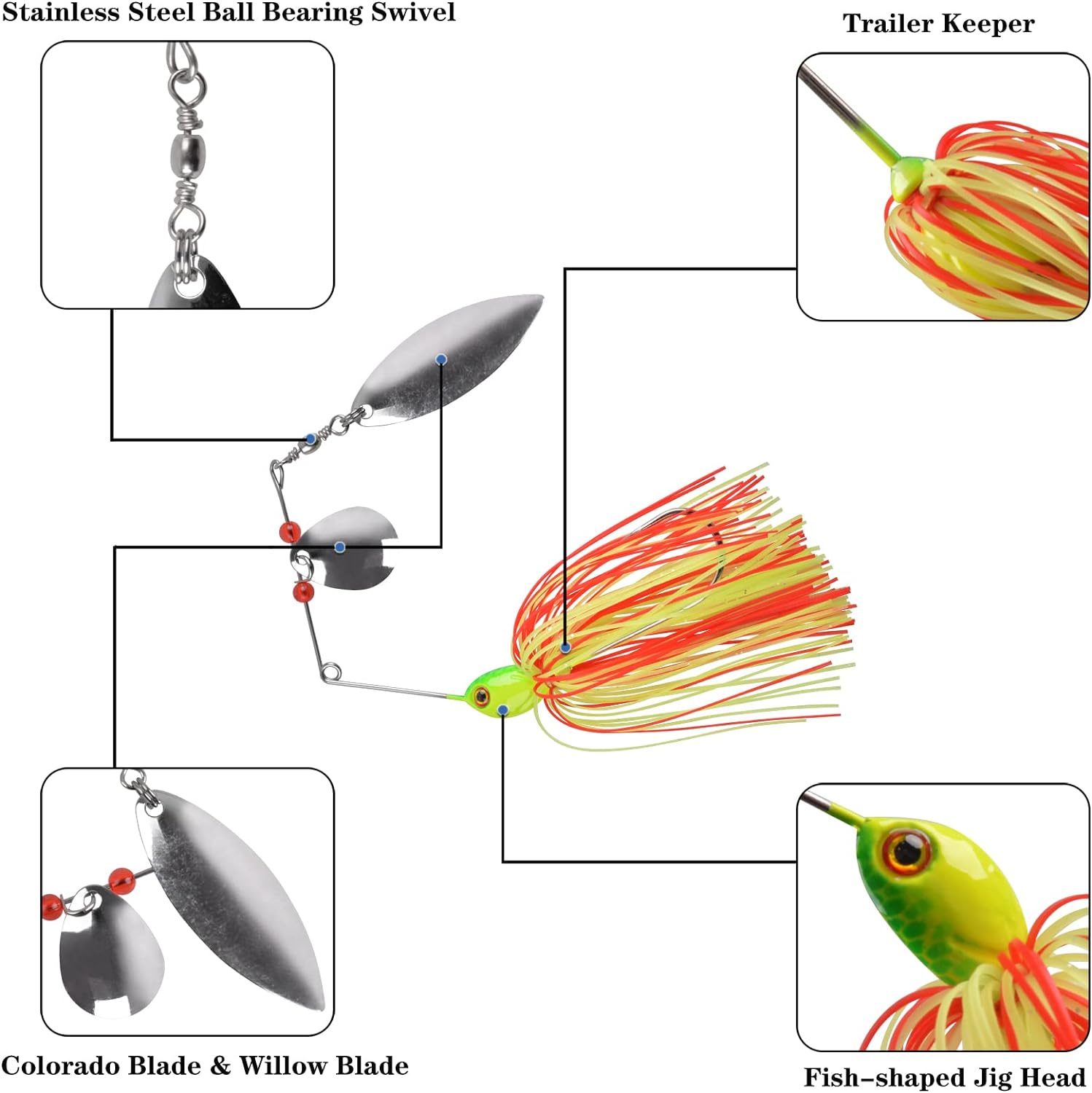
Pros:
✅ Versatile and can be used in various conditions.
✅ Less likely to get snagged due to its design.
✅ Customizable for different scenarios.
Cons:
⚠️ Some anglers find it challenging to set the hook due to its flexible wire frame.
⚠️ Might not be as enticing in waters where fish have seen a lot of spinnerbaits.
⚠️ Requires regular maintenance to ensure blade rotation and skirt condition.
securely, on Amazon's website
Benefits of Spinnerbaits:
Visibility: The spinning blades reflect light and create vibrations in the water, making them easy for bass to detect, even in murkier conditions.
Weedless Design: The safety-pin design helps it avoid getting snagged, allowing you to navigate through heavy cover.
Customizable: Switch out blades and skirts to adjust to different conditions and bass preferences.
How to Use Them:
Slow Roll: Retrieve the spinnerbait just fast enough to keep the blades spinning, allowing it to stay deep and close to cover or structure.
Yo-Yo Technique: Let it sink a bit and then retrieve in an up-and-down motion, similar to a yo-yo.
Burn and Kill: Retrieve rapidly, then abruptly stop, allowing the spinnerbait to fall, resembling a dying baitfish.
When and Where to Use:
Murky Waters: The flash and vibration from the blades make it ideal for less clear conditions.
Around Cover: The weedless design lets you cast near logs, weeds, and rocks without many snags.
Tips:
Blade Choices: Willow-leaf blades work great in clearer waters, while Colorado blades are perfect for murkier depths due to their higher vibration.
Color Variation: In clear water, use natural colors, but in cloudy or murky water, bright colors can be more effective.
2. Best for Deep Water: Crankbaits
Crankbaits are the Swiss Army knives of the bass fishing world. They can dive, wiggle, and flash, mimicking the erratic movements of a fish's natural prey. But their real strength? The depth they can reach.
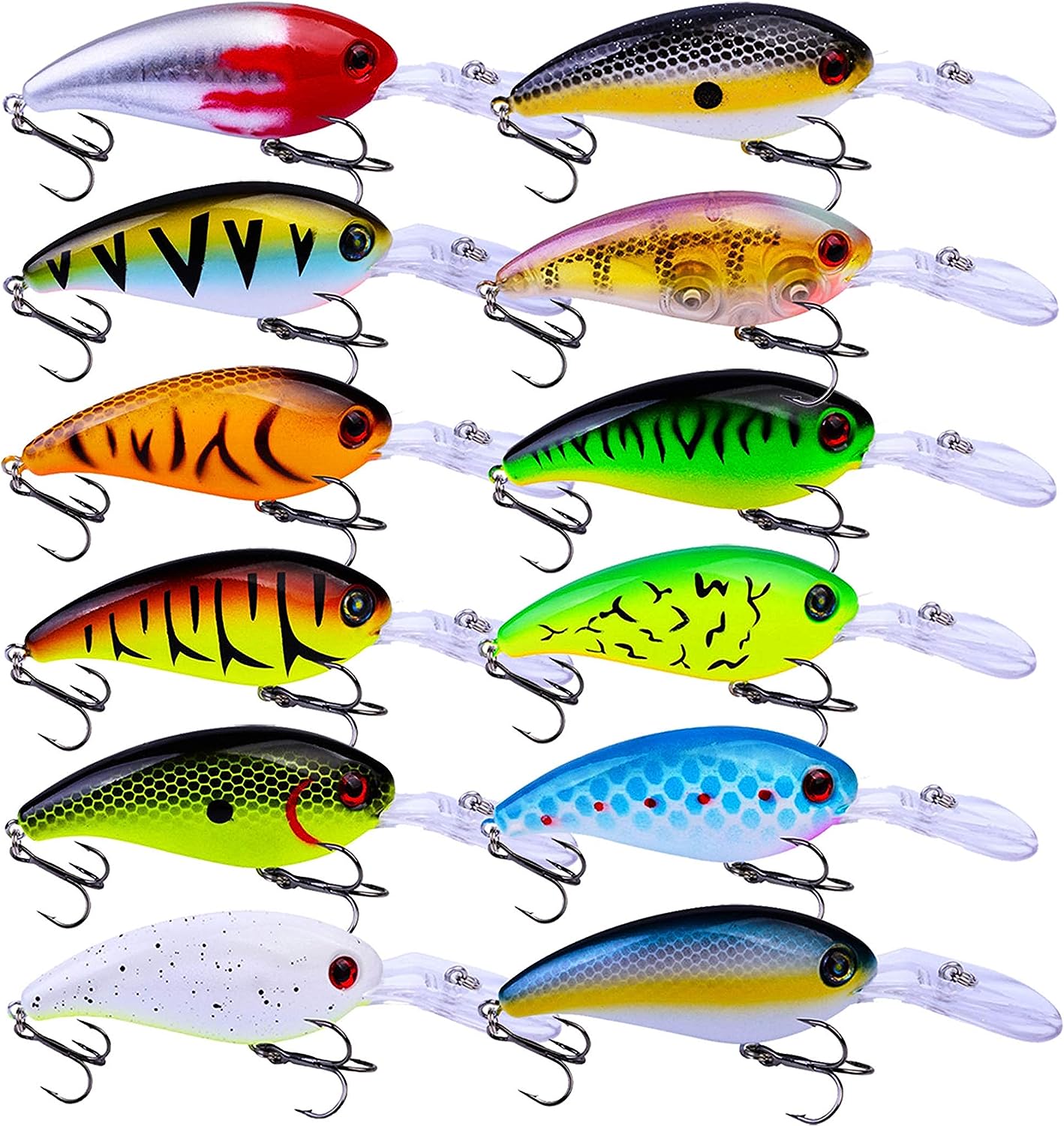
Pros:
✅ Reaches deeper depths than most lures.
✅ Highly versatile in design and application.
✅ Effective around structures.
Cons:
⚠️ Can get snagged easily if not used correctly.
⚠️ Requires occasional tuning to maintain effectiveness.
⚠️ Might not be as effective in heavily pressured waters where fish are more wary.
securely, on Amazon's website
Benefits of Crankbaits:
Versatility: Crankbaits can be used in various water conditions, from clear to muddy. The key is to pick the right color for the water condition.
Range of Depths: With different lip sizes and body designs, crankbaits can reach from shallow waters to the deep haunts where big bass lurk.
Mimicry: Their design allows them to emulate the movement of injured baitfish – an irresistible temptation for bass.
How to Use Them:
1. Retrieving Technique: Start with a steady retrieve to get the bait to its desired depth. Once there, you can play around with the speed, occasionally pausing or twitching the rod tip to mimic an injured fish.
2. Tuning: It's crucial to ensure your crankbait swims straight. If it veers to one side, adjust the line tie slightly in the opposite direction.
3. Bumping: Let the crankbait bump into submerged structures like rocks, trees, or even the bottom. This can trigger bites as bass often attack what they perceive as vulnerable prey.
When and Where to Use:
Deep Waters: Especially during summer months when bass seek cooler, deeper waters.
Around Structure: Casting near submerged trees, rock piles, and drop-offs can be productive.
Tips:
Change Up: Switch colors or sizes if one isn't working. Bass can be picky!
Rattle or Silent: Some crankbaits come with internal rattles. Depending on the mood of the fish, choose between a noisy or silent approach.
3. Best from Shore: Topwater Popper
For those heart-stopping moments when a bass erupts from the water, topwater poppers are your ticket. These lures work on the water's surface, creating a ruckus that's hard for any bass to resist.

Pros:
✅ Highly exciting with visual surface strikes.
✅ Effective in shallow waters and during specific times of the day.
✅ Requires minimal gear adjustments.
Cons:
⚠️ Limited to surface action; won't target deeper-lurking bass.
⚠️ Highly dependent on the right water conditions.
⚠️ Missed strikes can be common as bass might just slap at it without getting hooked.
securely, on Amazon's website
Benefits of Topwater Poppers:
Surface Action: The popping and splashing action mimics wounded prey on the water's surface.
Visual Strikes: There's nothing quite like seeing a bass attack a topwater lure. It's an adrenaline rush every angler lives for.
Effective in Shallow Waters: Especially useful during the early morning or late evening when bass are in shallow areas.
How to Use Them:
1. Pop and Pause: Cast out and let the ripples dissipate. Then, jerk the rod tip to make the lure pop and splash. Allow it to rest, and then repeat.
2. Walking the Dog: With a rhythm, twitch your rod tip to make the popper move side to side in a zigzag pattern.
When and Where to Use:
Shallow Waters: Particularly near the shores, around lily pads, docks, and logs.
Calm Days: Poppers work best when the water's surface is relatively calm, making their disturbance more noticeable.
Tips:
Time It Right: Early mornings and late evenings, during the "magic hours," are prime times for topwater fishing.
Patience: After a strike, wait a second before setting the hook. Bass often swipe at the lure first and then come back to grab it.
4. Best for Cover: Jigs
Often described as the go-to lure when the fishing gets tough, jigs are versatile baits that can probe the depths and navigate through heavy cover with ease.
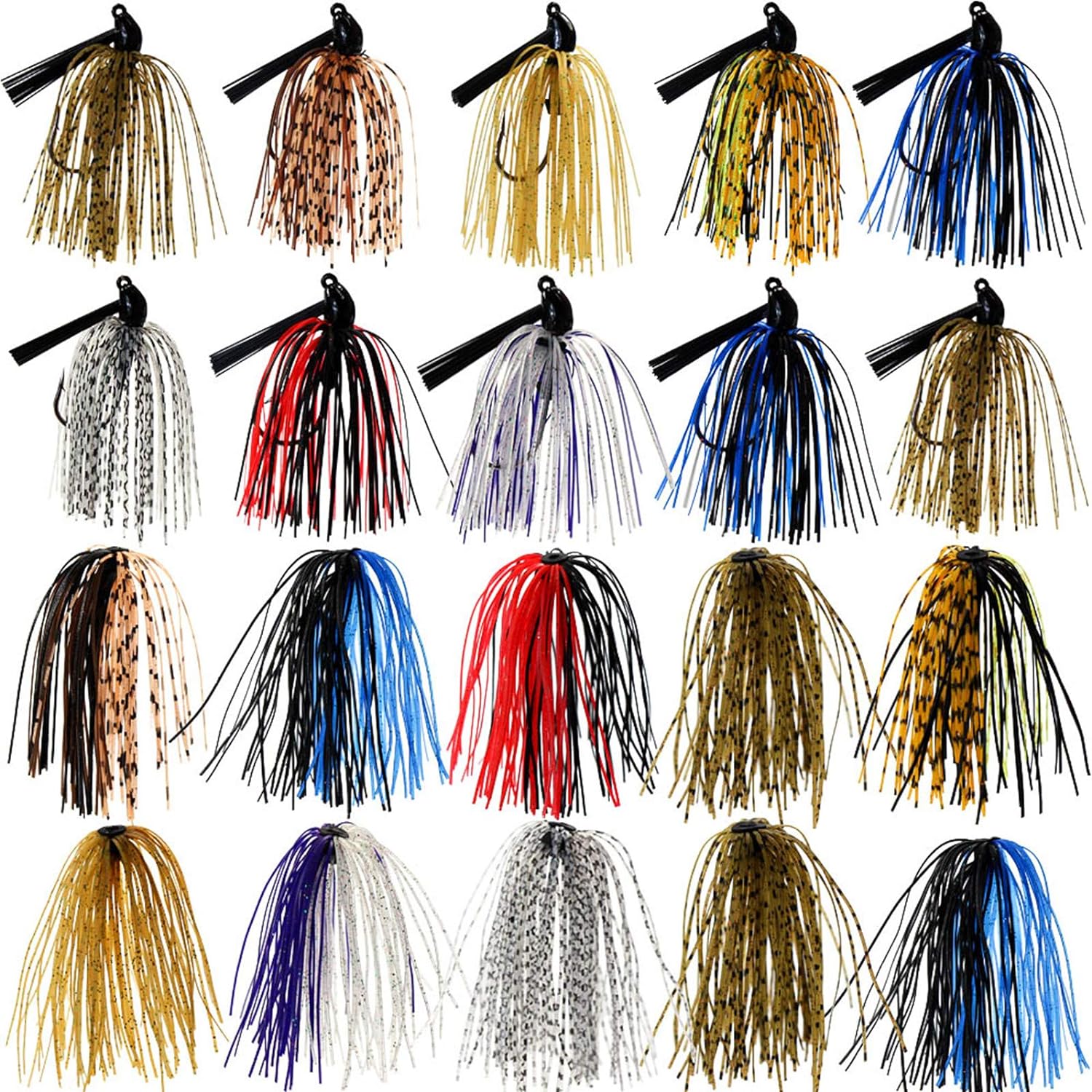
Pros:
✅ Extremely versatile and can be used in different water conditions.
✅ Effective in probing depths where bass hide.
✅ Weed-guard prevents frequent snags.
Cons:
⚠️ Requires patience and a keen sense of feel to detect subtle bites.
⚠️ Proper presentation might demand more skill than other lures.
⚠️ Lighter jigs might be hard to cast on windy days.
securely, on Amazon's website
Benefits of Jigs:
Adaptable: Jigs can be used year-round in various depths and conditions.
Heavy Cover Pros: Their design allows them to be fished in areas where bass hide but other lures would get snagged.
Natural Presentation: With the right technique, jigs mimic the movement of crustaceans and baitfish, enticing bass to strike.
How to Use Them:
1. Drag and Pause: Cast it out, let it sink to the desired depth, and slowly drag it along the bottom with occasional pauses.
2. Hop and Pop: Use your rod tip to give the jig little hops, resembling a crayfish's movement.
3. Swimming: Retrieve the jig steadily, making it look like a swimming baitfish.
When and Where to Use:
Heavy Cover: Areas with lots of rocks, logs, or aquatic vegetation are perfect for jigs.
Deep Waters: During colder months when bass move to deeper structures.
Tips:
Trailer Choices: Adding soft plastic trailers like craws or grubs can enhance the jig's movement and appearance.
Color Coordination: Match the jig's color with the local forage or go for darker colors in murky waters.
5. Best in a Pond: Rubber Worms
When you're after bass in a pond, few lures match the effectiveness of the classic rubber worm. Its lifelike wriggle and the multitude of rigging options make it an invaluable tool for pond fishing.
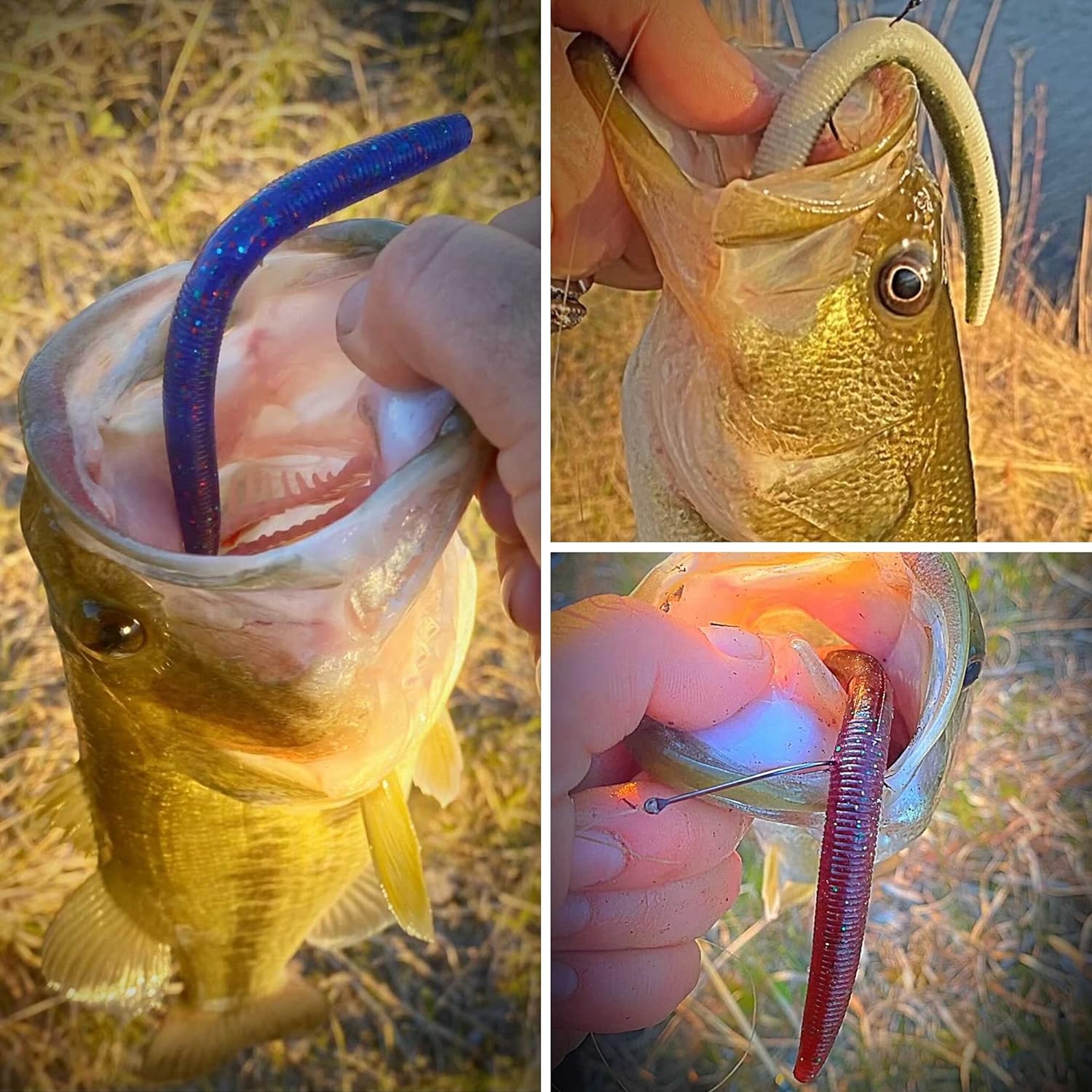
Pros:
✅ Highly effective in many conditions, especially ponds.
✅ Versatile rigging options cater to various scenarios.
✅ Lifelike presentation can convince even wary bass.
Cons:
⚠️ Soft material can be torn easily, especially with aggressive bites.
⚠️ Requires periodic replacement due to wear and tear.
⚠️ Proper rigging can be intimidating for beginners.
securely, on Amazon's website
Benefits of Rubber Worms:
Natural Movement: The undulating movement of a rubber worm is often irresistible to bass, mimicking the worms and other critters they feed on.
Various Rigging Options: Whether it's Texas-rigged, Carolina-rigged, or wacky style, there's a way to present a rubber worm for any situation.
Less Snagging: Depending on the rigging style, rubber worms can be presented weedlessly, making them ideal for areas with lots of cover.
How to Use Them:
1. Slow and Steady: The magic of a rubber worm often lies in its slow presentation. Let it sink and twitch it gently to entice bites.
2. Lift and Drop: Lift your rod tip slowly, making the worm rise in the water column, then let it fall back down naturally.
3. Shake It: A slight shaking of the rod tip can make the worm dance, attracting nearby bass.
When and Where to Use:
Ponds and Shallow Lakes: Especially near structures like submerged logs, vegetation edges, or docks.
Warmer Months: Rubber worms are particularly effective during the warmer parts of the year when bass are actively feeding.
Tips:
Color Matters: In clear waters, go for natural worm colors. In murkier waters, brighter colors like chartreuse or neon can stand out.
Size Variation: Depending on the bass's mood, switching between longer and shorter worms can make a difference.
6. Best in the Fall: Jerkbaits
When the leaves start to change and the water gets a crispness to it, jerkbaits come into their own. These slender, often minnow-like lures are designed to dart erratically, mimicking injured baitfish.

Pros:
✅ Excellent for triggering reactionary bites.
✅ Can cover various depths with the same lure.
✅ Mimics common bass prey, making it a trusted choice.
Cons:
⚠️ Less effective in very murky water due to its reliance on visibility.
⚠️ Requires a more active retrieval technique, which might not suit all anglers.
⚠️ Treble hooks can get snagged if fished in dense cover.
securely, on Amazon's website
Benefits of Jerkbaits:
Erratic Action: The unpredictable movement can trigger bites, even from bass that aren't actively feeding.
Diverse Depth Ranges: Depending on the model, jerkbaits can be fished from shallow to deep waters.
Imitates Forage: Their design closely resembles local baitfish, a primary food source for bass.
How to Use Them:
1. Twitch and Pause: Cast it out, retrieve with a series of twitches, and incorporate pauses. This makes the jerkbait dart and stop, resembling a wounded fish.
2. Steady Retrieve: In warmer waters, a constant retrieve with minor twitches can be effective.
3. Deep Diving: Some jerkbaits are designed to dive deeper—allow them to sink and then start your twitch-pause retrieval.
When and Where to Use:
Cooler Waters: Particularly during the fall transition when bass are chasing baitfish.
Clear to Slightly Stained Water: The visual aspect of jerkbaits works best in clearer conditions.
Tips:
Play with Pauses: Sometimes bass will strike during the pause, so experiment with the length of your stops.
Rod Position: A downward rod position can help achieve deeper dives during twitches.
7. Best When Nothing Else Works: Swimbaits
When versatility meets realism, you get swimbaits. These lures have made a name for themselves due to their lifelike appearance and swimming action, making them irresistible to bass of all sizes.
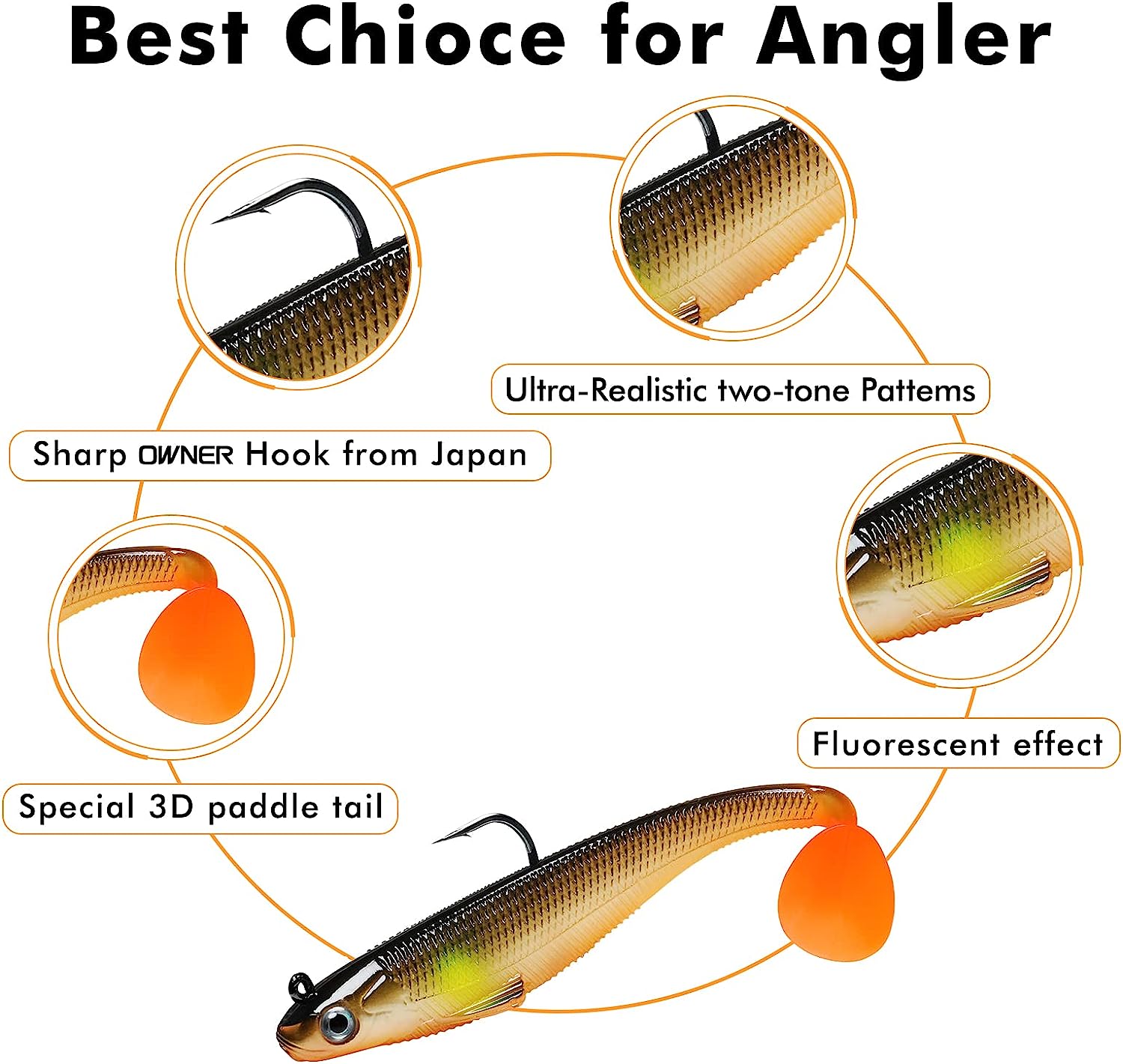
Pros:
✅ Incredible realism that can deceive even the smartest bass.
✅ Can target bass at any depth.
✅ Available in a wide range of sizes for various applications.
Cons:
⚠️ High-quality swimbaits can be pricey.
⚠️ Bigger versions require specialized gear.
⚠️ Can be heavy and challenging to cast for long durations.
securely, on Amazon's website
Benefits of Swimbaits:
Ultra-Realistic: Designed to emulate the exact appearance and movement of forage fish.
Size Range: From smaller profiles to giant versions, there's a swimbait to match any prey.
Depth Versatility: They can be fished at all levels, from surface to the very bottom.
How to Use Them:
1. Steady Retrieve: Simply casting and retrieving can make the swimbait do its magic, imitating a swimming fish.
2. Bottom Bouncing: Allow the swimbait to sink and then retrieve it, making it bounce off the bottom, resembling a feeding baitfish.
3. Slow Roll: Especially with big swimbaits, a slow, steady retrieve can entice monster bass looking for a big meal.
When and Where to Use:
Clear Waters: The realistic design shines in clear conditions where bass can get a good look.
Open Waters: While they can be fished in cover, open water allows swimbaits to truly swim and be noticed.
Pre-Spawn and Post-Spawn: Big females looking to feed heavily during these periods can't often resist a well-placed swimbait.
Tips:
Match the Hatch: Choose a swimbait size and color that closely matches the local baitfish.
Gear Up: Bigger swimbaits require sturdier rods and reels. Make sure you're adequately equipped.
8. Bonus Lure (it's always worth a shot): Chatterbait
Ah, the Chatterbait! Think of it as the wild card in your bass fishing arsenal. With its unique blade and jig combination, it brings together the best of both worlds, making it a favorite for many anglers.

Pros:
✅ Unique vibration and flash that stands out.
✅ Can be used in a variety of conditions and terrains.
✅ Weedless design makes it versatile.
Cons:
⚠️ Might require tuning out of the package for optimal performance.
⚠️ Blade can sometimes get stuck or not move as desired.
⚠️ It's not always the best for super clear waters.
securely, on Amazon's website
Benefits of Chatterbait:
Vibrant Action: The blade at the front creates a distinct vibration and movement in the water, drawing attention even from afar.
Versatile: Like a Swiss army knife, it can be fished slow, fast, deep, or shallow.
Weedless Design: It's made to come through cover without getting snagged, perfect for those tricky spots.
How to Use Them:
1. Steady Retrieve: Cast it out and reel it in. The blade will do its dance, attracting curious bass.
2. Variable Speeds: Mix up your retrieval speed. Sometimes, a change in tempo can provoke a strike.
3. Jig It: Thanks to its jig-like design, you can also bounce it off the bottom, adding another layer to its presentation.
When and Where to Use:
Murky Waters: The vibration can help bass locate the lure in low-visibility conditions.
Grassy Areas: It's designed to move through grass without snagging.
Pre-Spawn: Bass are aggressive just before the spawn, and a Chatterbait can be hard for them to resist.
Tips:
Add a Trailer: Soft plastic trailers can enhance the lure's profile and movement.
Color Choices: In murkier waters, go for brighter or contrasting colors to make it stand out.
Choosing the Top Lure for Bass
Navigating the intricate world of bass lures is far from a straightforward endeavor. Imagine walking into a store filled with walls of sparkling, colorful lures, each promising to be the key to your next big catch.
Overwhelming, right?
Finding the best bass lure isn't as simple as plucking the most eye-catching option off the shelf. It's an intricate balance of understanding the bass's behavior, matching the lure to specific conditions, and, of course, a little bit of luck. After all, if there were a universal solution, where would the challenge and thrill lie?
Brands to Trust
In a market saturated with products and promises, certain brands have consistently stood the test of time and nature. Rapala, for instance, has earned its stripes with its impeccable attention to detail in floating lures. Their products don't just look good; they perform, making them a favorite among pros and novices alike.
On the other end of the spectrum, we have Strike King. A brand that's diversified its lure range, especially with its spinnerbaits and crankbaits. What makes them stand out isn't just variety but their consistency in delivering results.
Zoom has taken a different route, focusing on soft plastics, particularly worms. It's their specialization and understanding of this niche that makes them a top choice when soft lures are the order of the day.
Last, but by no means least, Z-Man. Those familiar with the original Chatterbait will appreciate Z-Man's innovative spirit. It's brands like these that continually push the boundaries, making the angler's quest both challenging and rewarding.
Price vs. Quality
It's tempting to equate cost with quality, especially in the world of fishing where high prices sometimes reflect handcrafted precision. However, this isn't a golden rule. While you might come across a meticulously crafted swimbait with a hefty price tag, its effectiveness isn't always proportionally higher. Sometimes, a $5 crankbait can give it a run for its money, especially in certain conditions.
On the flip side, budget doesn't always mean compromise. There are lesser-known or budget-friendly brands out there that pack a punch well above their weight. These gems often combine innovative design with durable construction, ensuring you get value for your buck. So, while it's good to own a couple of premium lures for those special occasions, casting a wider (pun intended) net in terms of price range can lead to some delightful discoveries.
Fisherman’s Tips
Venturing into bass fishing can feel like stepping into a vast, complex world, but a few time-tested tips can make a world of difference.
1. First, redundancy is your friend. If a lure works wonders, odds are, at some point, it'll get snagged or lost. Having backups ensures that your golden streak isn't interrupted by such misadventures.
2. Next, embrace variety. While we all have our favorites, bass can be finicky. Changing colors, even sizes, can reignite their interest. It's not just about the lure, but how it's presented. Think of it as a culinary experience for the bass. Sometimes, they crave something different.
3. Don't shy away from seeking advice. Whether it's a fellow angler on the shore or discussions in online forums, the fishing community is rife with shared experiences and insights.
4. Seasons change, and so should your lures. While a topwater lure might be your summer favorite, it might not have the same appeal during cooler months.
5. Lastly, enjoy the process. Fishing, at its core, isn't just about the catch but the entire experience. The anticipation, the environment, the thrill of the chase, and yes, the joy of finding that perfect lure. Because, in the end, it's not just about the bass but the stories, memories, and experiences we reel in.
Factors to Consider When Selecting a Bass Lure
Choosing the perfect bass lure goes beyond mere aesthetics. It's an exercise in understanding the environment, the prey, and the predator. Many factors intertwine to dictate the success of a lure on a particular day. While some may believe it's all about luck, seasoned anglers know that knowledge and adaptability play crucial roles. By being attuned to various factors, you can increase your chances of enticing that elusive big bass.
Season / Water Temps
Seasons shift, and with them, the temperatures of the waters we fish in. This thermometric dance has a profound influence on the behavior of bass. In warmer months, for instance, bass often venture into the shallows, seeking prey and warmer waters. This movement makes topwater lures and shallow-running crankbaits the weapons of choice, enticing bass with a tempting morsel just above their heads.
However, as the chill sets in, these fish retreat to the deeper sanctuaries of the water bodies. Here, lures like jigs or deep-diving crankbaits become essential, designed to reach the depths where bass are lurking. Essentially, keeping a finger on the pulse of the season and the corresponding water temperatures ensures your lure is always in the right place at the right time.
Water Conditions
Water is not just water. Its clarity, its motion, its very character can change from one location to another, and even from morning to afternoon. In pristine, clear waters, bass have the advantage of sight. They can scrutinize their potential prey with a discerning eye. This clarity calls for a lure that's as close to the real deal as possible—a realistic representation of the fish or critters bass might naturally feed on.
But murky waters change the game. Here, the bass are guided more by vibration and sound than sight. Bright, noisy lures can become your best allies, cutting through the murk with their presence. And it's not just about clarity. The state of the water, whether calm or turbulent, can also influence lure choice. While the serenity of still waters might call for a subtler approach, rougher waters demand lures that make their presence known, be it through enhanced motion or sound.
Local Cover
The underwater landscape is a world in itself. From the dense, weedy expanses to the rocky terrains, each environment presents its challenges and opportunities. Bass, the masters of ambush, use these terrains to their advantage. For the angler, understanding and adapting to these covers can be the difference between success and snag.
Dense vegetation calls for specific strategies. Weedless lures or designs that can glide over such covers without getting entangled become essential. Frogs, for instance, can be perfect for lily-pad laden waters. On the flip side, submerged timber or rocky bottoms have their own set of rules. Here, lures like jigs that can navigate these terrains without getting stuck, and still entice bass out of their hiding spots, are invaluable. In essence, the landscape dictates the tactics, and the wise angler always comes prepared.
Local Food Sources
In the vast menu of nature, bass have their favorites, and these favorites can change based on location. The principle of "matching the hatch" is rooted in this very observation. If, for instance, shad are the primary food source in a particular water body, lures that mimic their shape, color, and movement can be incredibly effective.
Yet, it's not just about mimicking the prey, but understanding its behavior. Crawfish, another bass favorite, have specific behaviors and patterns. Lures that can replicate not just their appearance but their movement, especially when coupled with the right retrieve technique, can be irresistible to bass. Every environment presents its buffet, and understanding what's on the menu can significantly enhance your success rate.
Live Bait vs. Artificial Lures: Key Differences from an Angler’s Perspective
The age-old debate rages on among anglers: live bait or artificial lures? Each comes with its merits and shortcomings, and the choice often boils down to individual preferences, the situation at hand, and the targeted fish species. But for the sake of clarity and to lend a hand to those still on the fence, let's dissect the key differences between the two from an angler's point of view.
Live bait, as the term suggests, involves using living creatures—be it worms, minnows, or insects—as a lure. The immediate advantage here is realism. No artificial lure can replicate the scent, taste, and nuanced movement of a live creature. When fish are particularly finicky or when angling in heavily pressured waters where fish have become wary of artificial lures, live bait can be a game-changer. The very presence of something alive and edible in the water can provoke predatory instincts in fish that artificials might not.
However, live bait comes with its challenges. There's the task of keeping the bait alive and in optimal condition, which can be cumbersome, especially on longer trips. Then, there's the ethical question for some anglers about using living creatures as bait. Some consider it inhumane or unsporting. Yet, others see it as a natural part of the fishing ecosystem, as predators in nature don't hunt plastic prey.
Artificial lures, on the other hand, offer convenience and versatility. Made of plastic, metal, or other materials, these lures can mimic a variety of prey—from fish to insects. Their durability means they can be used repeatedly, saving costs in the long run. Furthermore, with a range of designs, colors, and actions, an angler can adapt to different fishing conditions and target species with precision. One of the sheer joys of using artificial lures is the art of the retrieve; mastering the technique to make a lifeless piece of plastic dance and dart like a real creature is a skill many anglers cherish.
Yet, artificial lures aren't always the silver bullet. They lack the organic scent and taste of live bait, which can sometimes make the difference, especially when fish aren't in an aggressive mood. Also, the initial investment in a good range of lures can be hefty.
In the end, the debate between live bait and artificial lures is one of personal choice, shaped by experience, preference, and the specific circumstances of a fishing trip. Some swear by the authenticity of live bait, while others revel in the artistry and challenge of using artificials. As with many things in angling, there's no one-size-fits-all answer; only what works best for the individual in that moment on the water.
Conclusion
Fishing is as much an art as it is a science. The intricacies of selecting the perfect bass lure meld the knowledge of the environment with the understanding of fish behavior. From the material world of brands and pricing to the natural aspects like seasons, water conditions, and local food sources, the successful angler is one who adapts and learns.
While debates such as live bait vs. artificial lures will continue, there's no denying that both have their place in the angler's toolkit. Ultimately, consistent success on the water comes down to observation, experience, and a dash of old-fashioned intuition. So, whether you're casting from the shore with a trusty spinnerbait or trying out that new rubber worm in deeper waters, remember: fishing is a journey of discovery, with each cast offering a new lesson.
Determining the Right Lure for Bass Fishing: FAQs
Is there a lure that can consistently catch big bass?
While no single lure guarantees a big bass every time, certain lures like jigs and swimbaits have a reputation for attracting larger bass. It's essential, however, to consider the fishing conditions and adapt accordingly.
What’s a good lure weight when fishing for bass?
A good weight for a bass lure typically ranges between 1/8 oz to 1 oz. The choice depends on the depth you're targeting and the type of cover or structure you're fishing around.
What lure has won the most bass tournaments?
Jigs are often touted as the most successful tournament lures. Their versatility and ability to imitate various bass prey make them a favorite among competitive anglers.
Does lure color matter?
Absolutely. Lure color can influence visibility and attractiveness to bass. In clearer waters, natural colors often work best, while brighter or contrasting colors might be more effective in murky conditions.
Do heavier lures cast farther?
In general, yes. Heavier lures tend to cast farther due to the added weight. This can be particularly useful when trying to cover large areas of water or when fishing in windy conditions.
How do you know how deep a lure will go?
A lure's diving depth is influenced by its design, lip size, and the line used. Many crankbaits and similar lures specify their diving depths on the packaging. Experimenting and experience also play a crucial role in gauging depth.